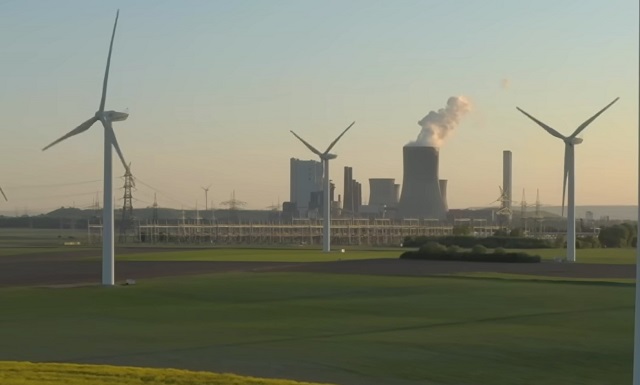Energy
Market Realities Are Throwing Wrench In Biden’s Green Energy Dreams

 From the Daily Caller News Foundation
From the Daily Caller News Foundation
For two years now, I and others have been pointing out the reality that there is no real “energy transition” happening around the world. Two new items of information came to light this week that irrevocably prove the point.
It is true that governments across the western world appear to be working to bankrupt their countries by pouring trillions of debt-funded dollars, Euros and British pounds into central planning efforts to subsidize renewables and electric vehicles into existence. That reality cannot be denied. The trouble is that no amount of debt money can turn the markets and the markets aren’t cooperating.
Despite all the government largesse that has spurred major additions of wind and solar generation capacity, those weather-reliant energy sources can’t even keep up with the pace of rising demand for electricity. As a result, the markets dictated that the world consumed record levels of coal, natural gas, oil and even wood during 2023. Yes, we are still burning vast amounts of wood for electricity, despite an alleged “transition” from wood to coal which began 500 years ago.
That is reality, dictated by the markets.
Two new bits of data came to light this week that pound the final nails into the coffin of the narrative around the energy transition. A report in the Financial Times, citing data compiled by Grid Strategies, reveals that the buildout of new high-voltage transmission lines in the United States slowed to a trickle in 2023, with just 55.5 additional miles installed. That collapse comes despite the Biden government’s recognition that a massive expansion of this type of transmission lines must happen to accommodate the demands of any true “transition” to renewables.
The Financial Times quotes a 2023 assessment by the Department of Energy that found that “regional transmission must more than double and interregional transmission must grow more than fivefold by 2035 to meet decarbonization targets.” DOE admits such a pace would add more than 50,000 miles of new transmission in just 11 years, which is almost 1,000 times the pace of adds during 2023. Yikes.
A crucial aspect of that DOE study to understand is that it was conducted before we began to understand the true magnitude of additional power demands that will result from the explosive growth of AI technology just now starting to come to full bloom. It was just this past January, at the WEF Forum in Davos, where OpenAI CEO Sam Altman told the audience he believes generation capacity on the grid will have to double over the next decade just to fill the AI demands alone. That is what is needed in addition to the rising demands for EV charging, industrial growth, population growth and economic growth.
The second piece of compelling data arising this week comes from a Bloomberg story headlined, “Data Centers Now Need a Reactor’s Worth of Power, Dominion Says.” The key thing to understand about this story is that the piece is only referencing the needs of planned new data centers being built in Northern Virginia to feed AI development in that tiny sliver of the United States.
This key excerpt from the story says it all: “Over the past five years, Dominion has connected 94 data centers that, together, consume about four gigawatts of electricity, Blue said. That means that just two or three of the data center campuses now being planned could require as much electricity as all the centers Dominion hooked up since about 2019.”
That is not just rapid growth, it is exponential growth in power demand from a single developing technology.
Demand growth needs such as this aren’t going to be filled by unpredictable, unreliable, weather-dependent generation like windmills and solar arrays. And let’s face it: The United States is not going to be able to continue expanding renewables without finding some way to create a massive expansion of transmission. Why build the generation if you can’t move the electricity?
What it all means is that all the grand Biden Green New Deal plans to shut down America’s remaining coal fleet and much of its natural gas generation fleet are going to have to wait, because the market will not allow them. That’s reality, and reality does not care about anyone’s green transition dreams.
David Blackmon is an energy writer and consultant based in Texas. He spent 40 years in the oil and gas business, where he specialized in public policy and communications.
The views and opinions expressed in this commentary are those of the author and do not reflect the official position of the Daily Caller News Foundation.
Energy
Fossil fuels not going away anytime soon

From the Fraser Institute
At a time of persistent cost of living pressures and mounting worldwide geopolitical tension, it’s not surprising that energy issues are in the spotlight in Canada and beyond.
Earlier this year, the Trudeau government decided to freeze its carbon tax for home heating fuels in Atlantic Canada in the face of ferocious opposition to further tax hikes from premiers, local communities and MPs in the region. Smart politicians understand that Canadians today are attuned as never before to energy prices, including fuel prices at the pump.
With policymakers in Canada and elsewhere also preoccupied with climate change, we are exposed to sharply conflicting narratives about the future of energy. In one corner are those who spy a rapid and epic shift away from the fossil fuels that still supply 80 per cent of the world’s energy. In the other corner are skeptics who doubt that the dominant place of fossil fuels in the energy system will soon disappear.
As the debate continues, the U.S. Energy Information Administration (EIA) is an important source of well-grounded information. It provides regular updates on trends in energy supply and demand, both in the United States and globally. EIA forecasts deserve attention given the agency’s solid track record of predicting energy market developments.
On crude oil prices, the EIA now believes the main U.S. benchmark price will hover between US$85 and $90 per barrel over 2024-25. That’s good news for Canada, as crude oil ranks as our number one export. In its May 2024 market update, the EIA observes that “the startup of the Trans Mountain pipeline expansion… will alleviate existing distribution bottlenecks and allow for a gradual increase in oil production.” While one would never know it from scanning federal government news releases, Canadian oil production and export volumes are set to climb over the rest of the decade. And Canada’s energy-based export earnings will also receive a sizable boost once shipments of liquified natural gas (LNG) commence from LNG projects nearing completion in British Columbia.
Meanwhile, the EIA sees global oil consumption increasing further, after dipping briefly during the pandemic, reaching 105 million barrels per day by 2026.
Globally, there’s little evidence that consumers are turning away from petroleum and other liquid fuels, contrary to the claims of some Canadian politicians and environmental groups. Amid endless chatter about energy transitions and governments allocating gargantuan sums to an expanding hodgepodge of programs to reduce greenhouse gas (GHG) emissions, the world collectively still depends on oil and other carbon-based fuels for the vast majority of its energy.
None of this is surprising. The “dense” energy provided by fossil fuels is greatly valued by consumers and remains difficult to replace with other primary energy sources. Fossil fuels have played a central role in economic development since the dawn of industrialization. That will not change anytime soon.
Which is why the EIA doesn’t expect much progress in reducing GHG emissions in the coming one or two decades. In its recent comprehensive forecast, it projects that “global energy-related… emissions will increase through 2050” under almost all of the policy scenarios it models.
How can that be, with all of the political attention being given to climate change in many countries? Because rising populations and incomes, particularly in China, India and other emerging economies, “will offset the effects of declining energy and carbon intensity on emissions.” And also because outside of the electricity sector, there simply aren’t enough reliable cost-effective non-fossil fuel energy sources to satisfy the world’s still growing need for energy.
Author:
Energy
New Report Reveals Just How Energy Rich America Really Is

 From the Daily Caller News Foundation
From the Daily Caller News Foundation
A new report by the Institute for Energy Research (IER), a nonprofit dedicated to the study of the impact of government regulation on global energy resources, finds that U.S. inventories of oil and natural gas have experienced stunning growth since 2011.
The same report, the North American Energy Inventory 2024, finds the United States also leading the world in coal resources, with total proven resources that are more than 53% bigger than China’s.
Despite years of record production levels and almost a decade of curtailed investment in the finding and development of new reserves forced by government regulation and discrimination by ESG-focused investment houses, America’s technically recoverable resource in oil grew by 15% from 2011 to 2024. Now standing at 1.66 trillion barrels, the U.S. resource is 5.6 times the proved reserves held by Saudi Arabia.
The story for natural gas is even more amazing: IER finds the technically recoverable resource for gas expanded by 47% in just 13 years, to a total of 4.03 quadrillion cubic feet. At current US consumption rates, that’s enough gas to supply the country’s needs for 130 years.
“The 2024 North American Energy Inventory makes it clear that we have ample reserves of oil, natural gas, and coal that will sustain us for generations,” Tom Pyle, President at IER, said in a release. “Technological advancements in the production process, along with our unique system of private ownership, have propelled the U.S. to global leadership in oil and natural gas production, fostering economic benefits like lower energy prices, job growth, enhanced national security, and an improved environment.”
It is key to understand here that the “technically recoverable” resource measure used in financial reporting is designed solely to create a point-in-time estimate of the amount of oil and gas in place underground that can be produced with current technology. Because technology advances in the oil and gas business every day, just as it does in society at large, this measure almost always is a vast understatement of the amount of resource that will ultimately be produced.
The Permian Basin has provided a great example of this phenomenon. Just over the past decade, the deployment of steadily advancing drilling and hydraulic fracturing technologies has enabled producers in that vast resource play to more than double expected recoveries from each new well drilled. Similar advances have been experienced in the other major shale plays throughout North America. As a result, the U.S. industry has been able to consistently raise record overall production levels of both oil and gas despite an active rig count that has fallen by over 30% since January 2023.
In its report, IER notes this aspect of the industry by pointing out that, while the technically recoverable resource for U.S. natural gas sits at an impressive 4.03 quads, the total gas resource in place underground is currently estimated at an overwhelming 65 quads. If just half of that resource in place eventually becomes recoverable thanks to advancing technology over the coming decades, that would mean the United States will enjoy more than 1,000 years of gas supply at current consumption levels. That is not a typo.
Where coal is concerned, IER finds the US is home to a world-leading 470 billion short tons of the most energy-dense fossil fuel in place. That equates to 912 years of supply at current consumption rates.
No other country on Earth can come close to rivaling the U.S. for this level of wealth in energy mineral resources, and few countries’ governments would dream of squandering them in pursuit of a political agenda driven by climate fearmongering. “And yet, many politicians, government agents, and activists seek to constrain North America’s energy potential,” Pyle says, adding, “We must resist these efforts and commit ourselves to unlocking these resources so that American families can continue to enjoy the real and meaningful benefits our energy production offers.”
With President Joe Biden and former President Donald Trump staking out polar opposite positions on this crucial question, America’s energy future is truly on the ballot this November.
David Blackmon is an energy writer and consultant based in Texas. He spent 40 years in the oil and gas business, where he specialized in public policy and communications.
-

 Economy2 days ago
Economy2 days agoPrime minister’s misleading capital gains video misses the point
-

 Frontier Centre for Public Policy1 day ago
Frontier Centre for Public Policy1 day agoThe Great Canadian Hoax exposed
-

 International1 day ago
International1 day agoFormer GOP Republican Presidential Candidate Buys Activist Stake In Left-Wing Outlet
-

 conflict2 days ago
conflict2 days ago‘What’s The Problem?’: Zelenskyy Says NATO Needs To ‘Shoot Down’ Russian Missiles In Ukraine’s Airspace
-

 COVID-191 day ago
COVID-191 day agoBiden’s Navy secretary says he has ‘no regrets’ about firing 5,000+ unvaxxed sailors, Marines
-

 COVID-191 day ago
COVID-191 day agoSaskatchewan appeals court upholds COVID-era gov’t restrictions on outdoor gatherings
-

 Crime1 day ago
Crime1 day agoSoros-Backed DA Poised To Lose To Challenger In Ultra-Liberal County
-

 International24 hours ago
International24 hours agoNew bill would have exposed alleged conflicts in Biden, Trump presidencies






